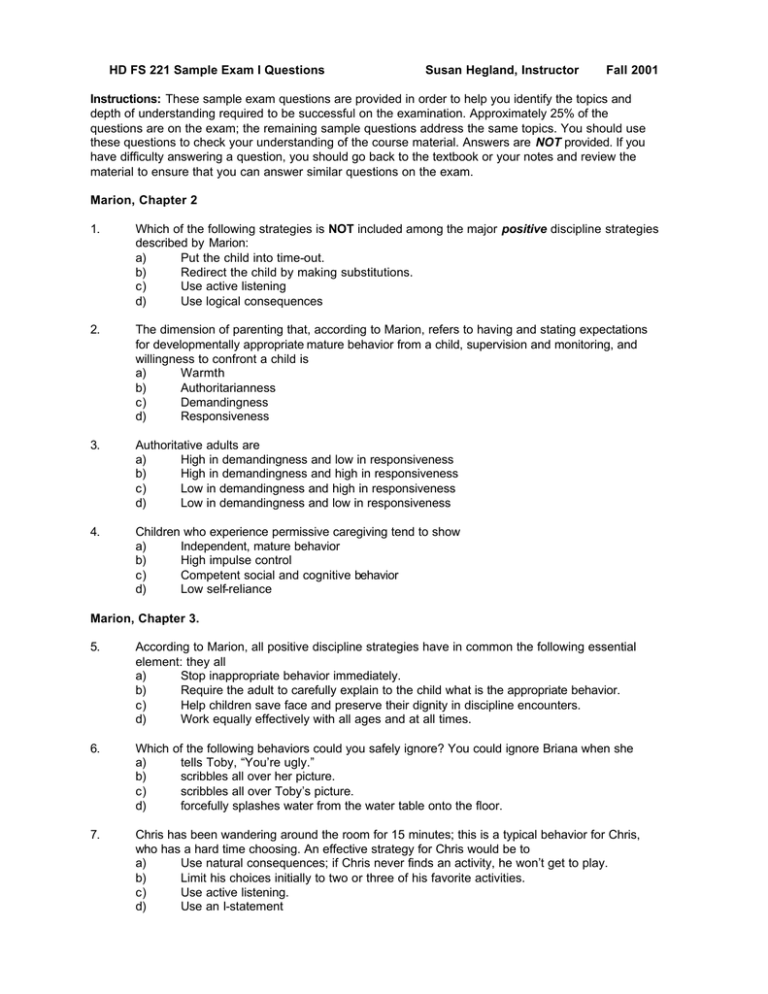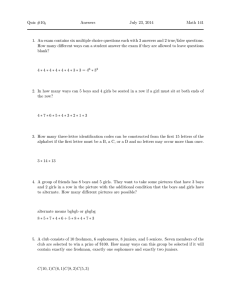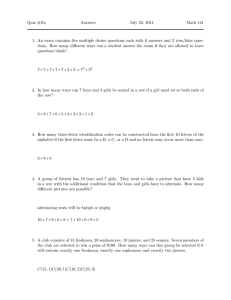depth of understanding required to be successful on the examination.... questions are on the exam; the remaining sample questions address... HD FS 221 Sample Exam I Questions
advertisement

HD FS 221 Sample Exam I Questions Susan Hegland, Instructor Fall 2001 Instructions: These sample exam questions are provided in order to help you identify the topics and depth of understanding required to be successful on the examination. Approximately 25% of the questions are on the exam; the remaining sample questions address the same topics. You should use these questions to check your understanding of the course material. Answers are NOT provided. If you have difficulty answering a question, you should go back to the textbook or your notes and review the material to ensure that you can answer similar questions on the exam. Marion, Chapter 2 1. Which of the following strategies is NOT included among the major positive discipline strategies described by Marion: a) Put the child into time-out. b) Redirect the child by making substitutions. c) Use active listening d) Use logical consequences 2. The dimension of parenting that, according to Marion, refers to having and stating expectations for developmentally appropriate mature behavior from a child, supervision and monitoring, and willingness to confront a child is a) Warmth b) Authoritarianness c) Demandingness d) Responsiveness 3. Authoritative adults are a) High in demandingness and low in responsiveness b) High in demandingness and high in responsiveness c) Low in demandingness and high in responsiveness d) Low in demandingness and low in responsiveness 4. Children who experience permissive caregiving tend to show a) Independent, mature behavior b) High impulse control c) Competent social and cognitive behavior d) Low self-reliance Marion, Chapter 3. 5. According to Marion, all positive discipline strategies have in common the following essential element: they all a) Stop inappropriate behavior immediately. b) Require the adult to carefully explain to the child what is the appropriate behavior. c) Help children save face and preserve their dignity in discipline encounters. d) Work equally effectively with all ages and at all times. 6. Which of the following behaviors could you safely ignore? You could ignore Briana when she a) tells Toby, “You’re ugly.” b) scribbles all over her picture. c) scribbles all over Toby’s picture. d) forcefully splashes water from the water table onto the floor. 7. Chris has been wandering around the room for 15 minutes; this is a typical behavior for Chris, who has a hard time choosing. An effective strategy for Chris would be to a) Use natural consequences; if Chris never finds an activity, he won’t get to play. b) Limit his choices initially to two or three of his favorite activities. c) Use active listening. d) Use an I-statement 8. HD FS 221 Fall 2001 Exam I Sample Questions The adult notices that children are forgetting to use soap when they wash their hands. The most effective initial positive discipline strategy would be to a) Smell each child’s hands when she leaves the bathroom to ensure that soap has been use b) Use an I-statement, “When children don’t use soap to wash their hands, I get really worried, because the germs can make them sick.” c) Use active listening, “Sounds like you’re forgetting to use soap when you wash your hands.” d) Hang a picture of the hand-washing sequence next to the sink. Berk Chapter 2 9. Which environmental context has the first and longest-lasting influence on children’s development? a) Their social class b) Their family c) Their peer group d) Their school 10. The largest proportion of homeless families in the United States consists of a) Unemployed fathers with school-age children b) Unemployed women living by themselves. c) Single women with children under age 5. d) Men or women earning the minimum wage. 11. Neighborhoods have _____ impact on the development of young people in economically disadvantaged neighborhoods compared to those in well-to-do neighborhoods a) A greater b) A lesser c) No measurable d) Similar 12. A commonly held belief in United States culture is that the care and raising of children during their early years is the responsibility of a) Their parents only b) Their entire community c) Their extended family d) Schools and other government agencies. 13. Compared with other nations, how does the United States stand on indicators of child health and well-being? The United States a) Is ahead of almost all other nations b) Lags behind both industrial and developing nations c) Is about the same as other nations. d) Lags behind other industrialized nations. 14. Scott and Renee, who are both artists, have enrolled their young children in painting, drawing, and sculpting classes. This is an example of a(n) ________ genetic-environmental correlation. a) Passive b) Dynamic c) Evocative d) Active. 15. The epigenetic framework emphasizes that a) Heredity tends to restrict the development of some characteristics to just one of a few outcomes. b) Children’s experiences and behavior can affect gene expression. c) Individual differences in complex traits are due mainly to genetic factors d) Genetic-environmental correlations are driven entirely by genetics. 2 HD FS 221 Fall 2001 Exam I Sample Questions Berk Chapter 8 16. The best way of estimating a child’s physical maturity is to use a) skeletal age. b) height. c) weight. d) head circumference. 17. Most of the body’s systems follow the general growth curve. Which of the following does NOT follow this curve? a) the skeletal system b) the cardiovascular system c) the respiratory system d) the lymph system 18. In most right-handed individuals, the left hemisphere of the brain is manly responsible for a) memory. b) spatial skills. c) language skills. d) motor skills. 19. If a child’s emotional needs are completely neglected, the child could develop which of the following conditions? a) kwashiorkor b) deprivation dwarfism c) marasmus d) iron-deficiency anemia 20. Four-year-old Nancy spends most of her day at home alone, unsupervised. She has a very short stature, is light in weight in proportion to her height, has an immature skeletal age, and shows decreased GH secretion. She most likely has which of the following disorders? a) achondroplastic dwarfism b) acromegaly dwarfism c) deprivation dwarfism d) pituitary dwarfism 21. Hanna is 3 years old and eats only a few foods. Which of the following would you suggest to Hanna’s parents to encourage their daughter to eat a new food? a) serve her only the new food so that she has no choice but to eat it b) repeatedly expose her to the new food without any direct pressure to eat it c) forbid access to the foods that she does like d) bribe her with a cookie if she will finish the new food 22. In industrialized nations, the rate of childhood diseases has declined dramatically in the past 50 years, primarily as the result of a) generous government nutrition programs. b) government-funded health insurance. c) widespread immunization of infants and children. d) a reduction in the number of dangerous germs. 23. Children with frequent episodes of otitis media tend to have trouble paying attention to a) the speech of others. b) falling and staying asleep. c) mastering large motor skills, such as running and climbing. d) identifying the letters of the alphabet. 3 24. HD FS 221 Fall 2001 Exam I Sample Questions In industrialized nations, ___________ is/are the leading cause of death in early and middle childhood a) cancer b) unintentional injuries c) birth defects d) intentional injuries 25. By age 3, most children can a) feed themselves with a spoon. b) use a knife to cut soft foods. c) tie their shoes. d) dress and undress independently. 26. Which a) b) c) d) 27. Children first represent objects and events on paper by a) drawing only the boundaries of objects. b) a “tadpole person” drawing. c) making gestures that leave marks. d) drawing stick figures. 28. Which of the following milestones in children’s drawings permits them to draw their first picture of a person? a) being able to represent depth in their drawings b) using lines to represent the boundaries of objects c) the ability to represent legs and arms with lines d) being able to grasp a crayon with just the fingertips 29. When Victoria draws a picture of a person, she draws a circular shape head/body with lines sticking out for arms and legs. She adds a few details as eyes and mouth. Victoria is MOST likely a) 2 years old b) 4 years old c) 6 years old d) 8 years old 30. Three-year-old Donovan prints the letter D in his name backwards and seems quite satisfied with his erroneous creations. Which of the following statements is most likely concerning Donovan? a) Compared to children who do not reverse letters in their printing, Donovan is more likely to become left-handed or ambidextrous. b) Donovan’s brain is less strongly lateralized than those of children who do not reverse letters in their printing. c) Compared to children who do not reverse letters in their printing, Donovan is more likely to develop dyslexia. d) Donovan is developing typically, as many children reverse some letters in their printing well into the second grade. 31. Most 3-year-olds a) use an adult grip pattern to hold a pencil. b) vary their pencil grip depending on the types of marks that they are trying to make. c) grip a pencil in their palm rather than with their fingertips. d) write with pencils in both their left and right hands. of the following is the most complex self-help skill of early childhood? eating with utensils tying shoes fastening buttons brushing teeth 4 32. HD FS 221 Fall 2001 Exam I Sample Questions Which of the following is supported by research on the development of motor skills in early childhood? a) Boys have better balance than girls. b) Girls can jump farther than boys. c) Boys can hop and skip better than girls. d) Girls are ahead of boys in drawing skill. 33. Which of the following is MOST likely to promote the development of motor skills in early childhood? a) instructing children how to color between the lines in predrawn forms b) engaging children in daily routines, such as pouring juice and dressing c) teaching children how to perfect a range of motor skills, such as climbing, throwing, drawing, and sculpting d) enrolling children in gymnastics, tumbling, and other lessons 34. According to research by Eleanor Gibson, which of the following two letters would young children have the MOST difficulty telling apart? a) b and g b) m and w c) m and n d) p and q Berk Chapter 11 35. Which a) b) c) d) of the following statements about growth during the school years is true? Girls tend to grow in spurts, while boys’ growth is slow and steady. Boys tend to grow in spurts, while girls’ growth is slow and steady. Boys and girls both grow in spurts, with boys’ spurts occurring at slightly later ages. Boys and girls both grow in spurts, with girls’ spurts occurring at slightly later ages. 36. Your friend is curious about the changes that will occur in his 5-year-old son’s brain over the next few years. You inform him that a) growth in the frontal lobes and corpus callosum will slow and cease before age 7. b) the frontal lobes will double in surface area during the next 2 years due to new synaptic connections between neurons. c) the corpus callosum will thin out in a process called pruning. d) the frontal lobes will show a slight increase in surface area, due to continued myelinization. 37. Serious developmental problems, such as inattention and overactivity, emotional disturbance, and epilepsy, may occur when a) neurotransmitters are not present in appropriate balances. b) synaptic pruning occurs. c) the corpus callosum thickens. d) secretions from the adrenal glands increase. 38. The secretion of androgens occurs in a) school-age boys. b) school-age girls. c) adolescent boys. d) school-age girls and boys. 39. As Hong Kong has changed from a largely illiterate society to one that is highly educated, children have developed higher levels of a) malocclusion. b) farsightedness. c) otitis media. d) myopia. 5 40. HD FS 221 Fall 2001 Exam I Sample Questions Studies done in Kenya and Egypt reveal that the strongest dietary predictor of cognitive development in middle childhood is a) adequate amounts of vitamin b) sufficient consumption of fruits and vegetables. c) total calorie intake. d) quality protein from animal sources. 41. Research indicates that the best treatment for childhood obesity is a) daily exercise for the child. b) placing the child on a strict, low-calorie diet. c) punishing the child for sedentary activity. d) family-based interventions that focus on changing behaviors. 42. The most frequent cause of enuresis is a) that the child is too deeply asleep to awaken and urinate. b) abnormalities in the urinary tract. c) sleeping in a room that is too warm. d) a failure of the muscular responses that prohibit urination. 43. The most frequent cause of school absence in middle childhood is a) nocturnal enuresis. b) the common cold; c) asthma. d) bone fractures. 44. An 85% reduction in the risk of head injury is achieved by a) insisting that children wear protective helmets while bicycling, roller skating, or skateboarding. b) school-based programs that give children tangible rewards for acquiring safety skills. c) making sure that children are aware of bicycling, roller skating, and skateboarding safety rules. d) having children wear their seatbelts when traveling in a car. 45. Highly a) b) c) d) 46. If asked about “health”, 5-year-old Kenji would most likely say a) It has to do with how internal organs work. b) It is important to eat right so the body can build new muscles and bones. c) It is a matter of eating vegetables and wearing a jacket when the weather is cold. d) Nothing; he doesn’t understand the word. 47. Between the ages of 6 and 12, throwing speed and accuracy a) are equal for boys and girls. b) increase much more for boys than for girls. c) decrease for girls and for boys. d) increase for boys but not for girls. 48. The writing of 6-year-olds is quite large because they a) are sensitive to perceptual distinctions between mirror image forms. b) rely solely on horizontal and vertical motions. c) use just their wrists and fingers. d) use the entire arm to make strokes. . active boys have as much safety knowledge as their peers, but do not implement it. do not know as much about safety as their peers. know much more than their peers about safety but do not implement their knowledge. are more likely to implement safety precautions than their peers. 6 49. HD FS 221 Fall 2001 Exam I Sample Questions Six-year-old Karin a) can print her first and last names legibly. b) will learn to write lowercase letters before uppercase letters. c) can learn to write in cursive as easily as printing. d) cannot yet integrate two-dimensional shapes into her drawings. 50. School-age children’s participation in rule-oriented games is attributed to a) gains in perspective taking. b) gains in agility. c) physical maturation. d) adult supervision. 51. Who is most likely to affect children’s athletic attitudes and capabilities? a) Siblings b) Parents c) Coaches d) Teachers 52. Adrienne’s parents pressure her to participate in gymnastics. They criticize her performance Rough-and-tumble play among girls is a) nonexistent. b) more likely to involve hitting. c) more likely to include wrestling. d) more likely to include chasing. Material covered only in lecture: 53. Four-year-old Zack is drawing. An adult (who has not taken this course!) asks: “What are you drawing, Zack?” Zack: “How will I know until I’m done?” Based on Zack’s response, how would you interpret Zach’s development? For Zack, drawing is a) a process activity; he should be encouraged to paint more. b) a product activity; he should be encouraged to paint people, houses, or animals. c) Easy; he should be encouraged to work in other areas of the program instead. d) Hard; he should be encouraged to wait to draw until he is older. 54. Which of the following observations would lead you to refer Sean (4 years, 6 months old) for additional assessment after his first day in your program? a) Sean cannot ride a two-wheel bicycle. b) Sean holds a crayon in his fist to draw. c) Sean’s eyes wander and do not focus as he looks at you. d) Sean fails to successfully use scissors to cut paper. 55. What type of observational assessment is being used in the following example? For one hour, you are recording the number of 10-second intervals in which Colleen is on-task (that is, engaging in an appropriate activity) and the number in which she is off-task (that is, wandering, fighting, arguing, whining, etc.). When the beeper (in your ear) rings, you check whether she is on-task or off task. When you tally your checks, you find that Colleen was on-task during only 25% of the observed intervals. This observation is an example of a(n) a) Anecdotal record b) Time-sampling observational record. c) Event-sampling observational record. d) Running record. 7






